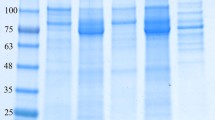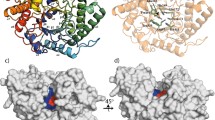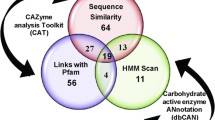Abstract
The composition of the cellulase system in the cellulosome-producing bacterium, Clostridium thermocellum, has been reported to change in response to growth on different carbon sources. Recently, an extensive carbohydrate-sensing mechanism, purported to regulate the activation of genes coding for polysaccharide-degrading enzymes, was suggested. In this system, CBM modules, comprising extracellular components of RsgI-like anti-σ factors, were proposed to function as carbohydrate sensors, through which a set of cellulose utilization genes are activated by the associated σI-like factors. An extracellular module of one of these RsgI-like proteins (Cthe_2119) was annotated as a family 10 glycoside hydrolase, RsgI6-GH10, and a second putative anti-σ factor (Cthe_1471), related in sequence to Rsi24, was found to contain a module that resembles a family 5 glycoside hydrolase (termed herein Rsi24C-GH5). The present study examines the relevance of these two glycoside hydrolases as sensors in this signal-transmission system. The RsgI6-GH10 was found to bind xylan matrices but exhibited low enzymatic activity on this substrate. In addition, this glycoside hydrolase module was shown to interact with crystalline cellulose although no hydrolytic activity was detected on cellulosic substrates. Bioinformatic analysis of the Rsi24C-GH5 showed a glutamate-to-glutamine substitution that would presumably preclude catalytic activity. Indeed, the recombinant module was shown to bind to cellulose, but showed no hydrolytic activity. These observations suggest that these two glycoside hydrolases underwent an evolutionary adaptation to function as polysaccharide binding agents rather than enzymatic components and thus serve in the capacity of extracellular carbohydrate sensors.





Similar content being viewed by others
References
Lamed R, Setter E, Bayer EA (1983) Characterization of a cellulose-binding, cellulase-containing complex in Clostridium thermocellum. J Bacteriol 156:828–836
Lamed R, Setter E, Kenig R, Bayer EA (1983) The cellulosome—a discrete cell surface organelle of Clostridium thermocellum which exhibits separate antigenic, cellulose-binding and various cellulolytic activities. Biotechnol Bioeng Symp 13:163–181
Bayer EA, Belaich J-P, Shoham Y, Lamed R (2004) The cellulosomes: multi-enzyme machines for degradation of plant cell wall polysaccharides. Annu Rev Microbiol 58:521–554
Dror TW, Rolider A, Bayer EA, Lamed R, Shoham Y (2005) Regulation of major cellulosomal endoglucanases of Clostridium thermocellum differs from that of a prominent cellulosomal xylanase. J Bacteriol 187:2261–2266
Gold ND, Martin VJ (2007) Global view of the Clostridium thermocellum cellulosome revealed by quantitative proteomic analysis. J Bacteriol 189:6787–6795
Raman B, Pan C, Hurst GB, Rodriguez M, McKeown CK, Lankford PK, Samatova NF, Mielenz JR (2009) Impact of pretreated Switchgrass and biomass carbohydrates on Clostridium thermocellum ATCC 27405 cellulosome composition: a quantitative proteomic analysis. PLoS ONE 4:e5271
Kahel-Raifer H, Jindou S, Bahari L, Nataf Y, Shoham Y, Bayer EA, Borovok I, Lamed R (2010) The unique set of putative membrane-associated anti-σ factors in Clostridium thermocellum suggests a novel extracellular carbohydrate-sensing mechanism involved in gene regulation. FEMS Microbiol Lett 308:84–93
Cantarel BL, Coutinho PM, Rancurel C, Bernard T, Lombard V, Henrissat B (2009) The Carbohydrate-Active Enzymes database (CAZy): an expert resource for glycogenomics. Nucl Acids Res 37:D233–D238
Lamed R, Kenig R, Setter E, Bayer EA (1985) Major characteristics of the cellulolytic system of Clostridium thermocellum coincide with those of the purified cellulosome. Enzyme Microb Technol 7:37–41
Demishtein A, Karpol A, Barak Y, Lamed R, Bayer EA (2010) Characterization of a dockerin-based affinity tag: application for purification of a broad variety of target proteins. J Mol Recogit (in press)
Miller GL (1959) Use of dinitrosalicylic acid reagent for determination of reducing sugar. Anal Biochem 31:426–428
Lineweaver H, Burk D (1934) The determination of enzyme dissociation constants. J Am Chem Soc 56:658–666
Moraïs S, Barak Y, Caspi J, Hadar Y, Lamed R, Shoham Y, Wilson DB, Bayer EA (2010) Contribution of a xylan-binding module to the degradation of a complex cellulosic substrate by designer cellulosomes. Appl Environ Microbiol 76:3787–3796
Finn RD, Tate J, Mistry J, Coggill PC, Sammut SJ, Hotz H-R, Ceric G, Forslund K, Eddy SR, Sonnhammer ELL, Bateman A (2008) The Pfam protein families database. Nucl Acids Res 36:D281–D288
Hunter S, Apweiler R, Attwood TK, Bairoch A, Bateman A, Binns D, Bork P, Das U, Daugherty L, Duquenne L, Finn RD, Gough J, Haft D, Hulo N, Kahn D, Kelly E, Laugraud A, Letunic I, Lonsdale D, Lopez R, Madera M, Maslen J, McAnulla C, McDowall J, Mistry J, Mitchell A, Mulder N, Natale D, Orengo C, Quinn AF, Selengut JD, Sigrist CJA, Thimma M, Thomas PD, Valentin F, Wilson D, Wu CH, Yeats C (2009) InterPro: the integrative protein signature database. Nucl Acids Res 37:D211–D215
Higgins DG, Thompson JD, Gibson TJ (1996) Using CLUSTAL for multiple sequence alignments. Methods Enzymol 266:383–402
Coutinho PM, Henrissat B (1999) Carbohydrate-active enzymes: an integrated database approach. In: Gilbert HJ, Davies GJ, Henrissat B, Svensson B (eds) Recent advances in carbohydrate bioengineering. R Soc Chem, Cambridge, pp 3–12
Henrissat B, Bairoch A (1993) New families in the classification of glycosyl hydrolases based on amino acid sequence similarities. Biochem J 293:781–788
Davies G, Henrissat B (1995) Structures and mechanisms of glycosyl hydrolases. Structure 3:853–859
Henrissat B, Callebaut I, Fabrega S, Lehn P, Mornon J-P, Davies G (1995) Conserved catalytic machinery and the prediction of a common fold for several families of glycosyl hydrolases. Proc Natl Acad Sci USA 92:7090–7094
Henrissat B, Davies G (1997) Structural and sequence-based classification of glycoside hydrolases. Curr Opin Struct Biol 7:637–644
MacLeod AM, Lindhorst T, Withers SG, Warren RA (1994) The acid/base catalyst in the exoglucanase/xylanase from Cellulomonas fimi is glutamic acid 127: evidence from detailed kinetic studies of mutants. Biochemistry 33:6371–6376
Tull D, Withers SG, Gilkes NR, Kilburn DG, Warren RA, Aebersold R (1991) Glutamic acid 274 is the nucleophile in the active site of a “retaining” exoglucanase from Cellulomonas fimi. J Biol Chem 266:15621–15625
Collins T, Gerday C, Feller G (2005) Xylanases, xylanase families and extremophilic xylanases. FEMS Microbiol Rev 29:3–23
Cottrell MT, Yu L, Kirchman DL (2005) Sequence and expression analyses of Cytophaga-like hydrolases in a western Arctic metagenomic library and the Sargasso Sea. Appl Environ Microbiol 71:8506–8513
Ducros V, Czjzek M, Belaich A, Gaudin C, Fierobe H-P, Belaich J-P, Davies GJ, Haser R (1995) Crystal structure of the catalytic domain of a bacterial cellulase belonging to family 5. Structure 3:939–949
Boraston AB, Bolam DN, Gilbert HJ, Davies GJ (2004) Carbohydrate-binding modules: fine-tuning polysaccharide recognition. Biochem J 382:769–781
Guillén D, Sánchez S, Rodríguez-Sanoja R (2010) Carbohydrate-binding domains: multiplicity of biological roles. Appl Microbiol Biotechnol 85:1241–1249
Bonnin E, Daviet S, Sorensen JF, Sibbesen O, Goldson A, Juge N, Saulnier L (2006) Behaviour of family 10 and 11 xylanases towards arabinoxylans with varying structure. J Sci Food and Agr 86:1618–1622
Beaugrand J, Chambat G, Wong VW, Goubet F, Rémond C, Paës G, Benamrouche S, Debeire P, O’Donohue M, Chabbert B (2004) Impact and efficiency of GH10 and GH11 thermostable endoxylanases on wheat bran and alkali-extractable arabinoxylans. Carbohydr Res 339:2529–2540
Dias FM, Goyal A, Gilbert HJ, Jose AMP, Ferreira LM, Fontes CM (2004) The N-terminal family 22 carbohydrate-binding module of xylanase 10B of Clostridium themocellum is not a thermostabilizing domain. FEMS Microbiol Lett 238:71–78
Fernandes AC, Fontes CM, Gilbert HJ, Hazlewood GP, Fernandes TH, Ferreira LMA (1999) Homologous xylanases from Clostridium thermocellum: evidence for bi-functional activity, synergism between xylanase catalytic modules and the presence of xylan-binding domains in enzyme complexes. Biochem J 342:105–110
Khasin A, Alchanati I, Shoham Y (1993) Purification and characterization of a thermostable xylanase from Bacillus stearothermophilus T-6. Appl Environ Microbiol 59:1725–1730
Acknowledgments
This research was supported by grants from the United States-Israel Binational Science Foundation (BSF, 2005–186), Jerusalem, Israel, by the Israel Science Foundation (grant numbers 966/09 and 159/07), and by the Mizutani Foundation for Glycoscience. Y.S. holds the Erwin and Rosl Pollak Chair in Biotechnology at the Technion. E.A.B. is the incumbent of The Maynard I. and Elaine Wishner Chair of Bio-organic Chemistry at the Weizmann Institute of Science.
Author information
Authors and Affiliations
Corresponding author
Rights and permissions
About this article
Cite this article
Bahari, L., Gilad, Y., Borovok, I. et al. Glycoside hydrolases as components of putative carbohydrate biosensor proteins in Clostridium thermocellum . J Ind Microbiol Biotechnol 38, 825–832 (2011). https://doi.org/10.1007/s10295-010-0848-9
Received:
Accepted:
Published:
Issue Date:
DOI: https://doi.org/10.1007/s10295-010-0848-9




